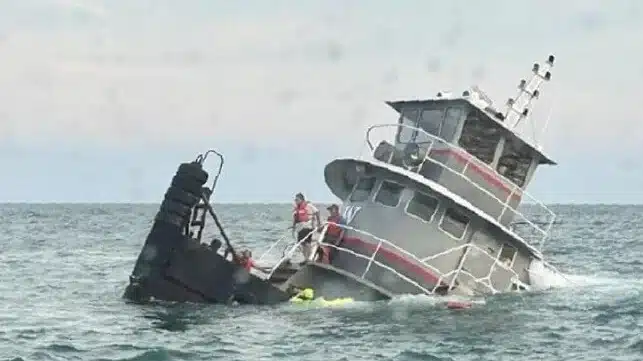NTSB: Corrosion in Void Spaces Sank Aging Tugboat
NTSB Report Reveals Causes Behind Tug Jacqueline A Sinking

The National Transportation Safety Board (NTSB) has released a detailed report on the sinking of the tug Jacqueline A, which occurred off the coast of South Carolina in the Atlantic Ocean. The investigation found that the vessel sank due to corrosion-induced holes in small void spaces above the lazarette, allowing water to infiltrate and causing progressive flooding through unsealed wire runs between compartments.
Jacqueline A, a 60-foot tug built in 1981, had been in service with a small towing company in Weems, Virginia, primarily used for barge tows on the Chesapeake Bay. The vessel was taken out of service in 2019 after failing to meet the requirements of the newly-implemented Subchapter M regulations for towing vessels. In mid-2023, the owner decided to return the tug to service, contracting a yard in Louisiana for necessary upgrades and repairs. The vessel’s captain and crew were hired to deliver the Jacqueline A to the yard, but unfortunately, the vessel’s structural integrity was not thoroughly inspected before the voyage.
On August 8, 2023, while navigating the open-ocean route from Cape Fear River to Port St. Lucie, Florida, the tug began taking on water. Initially, the captain noticed the tug listing to port and discovered that water was entering the engine room through unsealed wire runs connected to the lazarette. Despite efforts to start bilge pumps, the situation quickly escalated, leading the captain to issue a mayday call just before the radio went out. The Jacqueline A began to sink by the stern, but the crew managed to stay safe and were rescued by response boats. The tug fully sank after the rescue.
Following the incident, a salvage crew raised the vessel on August 21, revealing extensive damage. The post-casualty inspection uncovered severe corrosion and wastage in the tug’s structure, including significant holes in the deck plating and exterior bulwarks. The Coast Guard’s Marine Safety Center concluded that the unsealed wire runs and corrosion accelerated water ingress, causing the tug to sink rapidly. The NTSB’s findings emphasize the importance of avoiding small void spaces that can trap moisture and lead to undetected corrosion, as well as the necessity of properly sealing wire runs to prevent progressive flooding.
